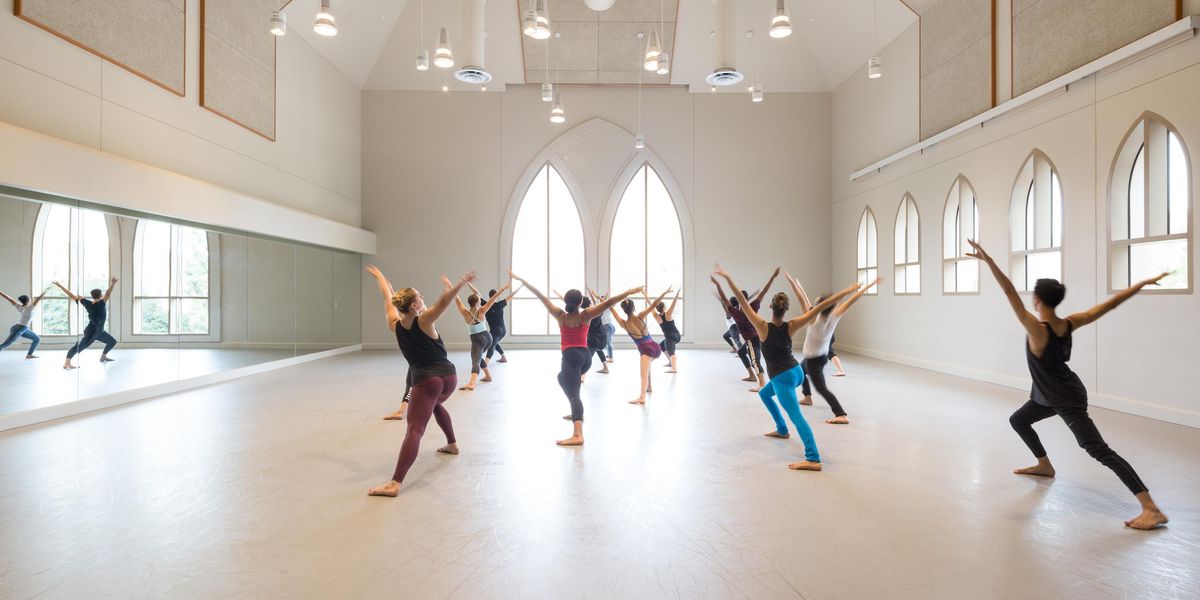On Broadway: Evita's Way
Elena Roger brings a dancer’s flair to the show’s tango moves.
Argentine style: Elena Roger, center, leads the ensemble in “Buenos Aires,” in
Evita’s hit London production. Photo by Johan Persson, Evita/London.
Eva Duarte grew up in rural Argentina in the 1920s and ’30s, dreaming of movie stardom in Buenos Aires. Elena Roger grew up in Buenos Aires in the ’70s and ’80s, studying music and dance and hoping, maybe, for a career in opera. Their destinies converged in Evita, the 1978 Tim Rice-Andrew Lloyd Webber musical back on Broadway in a dance-heavy revival directed by Michael Grandage.
The adored—and just as frequently reviled—Eva attained power and fame beyond her wildest dreams when she married Juan Perón and, in 1942, became First Lady of Argentina. Roger’s rise has not been quite as dizzying, but it’s pretty phenomenal nonetheless—an Olivier nomination after her London debut as Evita, then an Olivier award as Edith Piaf in Piaf, and a Broadway debut last month in Evita that is bound to be followed by another spurt of nominations, at least. Not bad for someone who was not even on the radar when Grandage and choreographer Rob Ashford first began discussing the 2006 London revival of the musical. The Broadway original, directed by Harold Prince and choreographed by Larry Fuller, won seven Tonys in 1979 and ran for over 1,500 performances.
Grandage and Ashford were wrapping up their work on the British revival of Guys and Dolls, Ashford recalls. “Michael said, ‘I’ve really enjoyed working with you,’ and I said, ‘Me too.’ And he said, ‘The next show I’m doing, Evita, doesn’t really have any dance. And I said, ‘That’s a shame for a show about a country where the very first word that comes to mind is a dance.’ ”
Ashford had spent three months in Buenos Aires, staging Kiss of the Spider Woman for Rob Marshall, and he’d returned frequently. “I fell in love with the city, with the people, and with the tango,” he says. By the time he and Grandage were finished talking, a tango-flavored vision of Evita was in the works.
Back in Buenos Aires, Roger was doing very nicely for herself in the city’s musical theater scene. Her big voice and acting ability had landed her in hit shows like Les Misérables and Beauty and the Beast, and she’d devised a successful vehicle for herself about the Italian pop star Mina Mazzini. But she might as well have been performing on the moon in terms of the West End and Broadway. She spoke barely any English; Evita had never played in Buenos Aires; she knew only one song from the show—the one everyone knows, “Don’t Cry for Me, Argentina.” But through the efforts of Ana Moll, an Andrew Lloyd Webber associate who knew her work, she was invited to London—at her own expense—to audition. And audition and audition and audition.
“I love London,” she says in her now serviceable English, with its Spanish, Evita-ready lilt. “I thought, ‘What can I lose if I go?’ I had the money. I wasn’t working, so I had the time. And it was a challenge. I like challenges. So I went.”
After several callbacks, Ashford says, Roger had not had a dance audition. “I totally knew,” he says, “that with the acting and the singing that it required, dance was definitely going to take third seat. It made total sense.” At last, Roger was sent to the studio to work with Christopher Bailey, Ashford’s frequent associate choreographer. When Ashford joined them, “just to see what we’ve got, Chris came over with a big smile, and said: ‘You’re going to be very happy.’ ”
Roger and Bailey did the little routine he had taught her—“a series of lifts, tango stuff, kicks, the whole bit”—and, Ashford says, “she was amazing. She was thrilling to watch dance. From that moment on, we just developed it for her.”
Roger had begun taking ballet at 8, in what she describes as a “very humble” studio in the working-class neighborhood of Barracas, where she grew up. When it closed, she badgered her mother into finding another school, and ended up studying two days a week with Marcela Avila, whose classes included Spanish dance, jazz, and tap as well as ballet. “I loved it,” Roger says. “We also had some classes about contemporary dance and tango and salsa.” She furthered her dance education watching Fred Astaire and Gene Kelly movies on television, and studied singing and piano as well. By 21, she was singing and dancing on the Buenos Aires stage.
Now that she’s on Broadway, the closest she’ll come to Buenos Aires is singing and dancing the “Buenos Aires” production number at the Marquis Theatre. And even if its rhythms aren’t authentically Argentinean, its moves often are. When Ashford was creating the choreography, she recalls, “he was doing something like a flamenco style with the hands”—she curves her arms over her head to demonstrate. “We have a lot of Spanish people in Argentina, and our folklore dance has a little bit of that style. But in Evita’s time, the tango was growing up. We had a lot of Italians. It’s all more sad, it’s darker, it’s all those immigrants that came with their sadness—it’s all down, not high.”
So the flamenco bit is gone, though Ashford’s characteristic high kicks remain. “It’s not a documentary,” she smiles. “It’s a show.”
Sylviane Gold writes on theater for
The New York Times.




